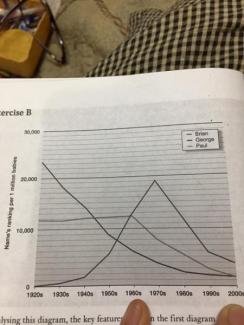The diagram below shows information about the usage of boys'names from 1920s to 2000s.
Summarise the information by selecting and reporting the main features, and make comparisons where relevant.

The line chart presents the statistical data on the change in the popularity of three boys' names namely Brian, George and Paul over 80-year period measured in term of their frequency per one million babies.
A closer study of the diagram illustrates that there was a dramatical decline of George over this period of time.
a series of data revealed that the ratio of George experienced a continued fall by approximately 21,000 boys per one milion babies. In contrast, the Brian's trend surged considerably to reach the peak at precisely 19,000 boys in 1970s. In addition, after the growth, it dropped to 4,000 in 2000s (the highest usage in this period). Additionally, the rate of using the name Paul remained constant at a little over 12,000 between 1920s and 1960s. However, it minimised dramatically by nearly 10,000 and it shared the same position with George in 2000s.
In conclusion, due to the favourite of parents and the names' meaning, the usage of three boys' names changed widely over this period.

Grammar and spelling errors:
Line 2, column 100, Rule ID: PERIOD_OF_TIME[1]
Message: Use simply 'period'.
Suggestion: period
... dramatical decline of George over this period of time. a series of data revealed that the r...
^^^^^^^^^^^^^^
Line 3, column 2, Rule ID: UPPERCASE_SENTENCE_START
Message: This sentence does not start with an uppercase letter
Suggestion: A
...e of George over this period of time. a series of data revealed that the ratio ...
^
Line 3, column 226, Rule ID: IN_1990s[1]
Message: The article is probably missing here: 'in the 1970s'.
Suggestion: in the 1970s
...reach the peak at precisely 19,000 boys in 1970s. In addition, after the growth, it drop...
^^^^^^^^
Line 3, column 287, Rule ID: IN_1990s[1]
Message: The article is probably missing here: 'in the 2000s'.
Suggestion: in the 2000s
..., after the growth, it dropped to 4,000 in 2000s the highest usage in this period. Addit...
^^^^^^^^
Line 3, column 539, Rule ID: IN_1990s[1]
Message: The article is probably missing here: 'in the 2000s'.
Suggestion: in the 2000s
...it shared the same position with George in 2000s. In conclusion, due to the favourite ...
^^^^^^^^
Transition Words or Phrases used:
however, in addition, in conclusion, in contrast
Attributes: Values AverageValues Percentages(Values/AverageValues)% => Comments
Performance on Part of Speech:
To be verbs : 1.0 7.0 14% => More to be verbs wanted.
Auxiliary verbs: 0.0 1.00243902439 0% => OK
Conjunction : 4.0 6.8 59% => More conjunction wanted.
Relative clauses : 2.0 3.15609756098 63% => OK
Pronoun: 9.0 5.60731707317 161% => Less pronouns wanted
Preposition: 34.0 33.7804878049 101% => OK
Nominalization: 2.0 3.97073170732 50% => More nominalizations (nouns with a suffix like: tion ment ence ance) wanted.
Performance on vocabulary words:
No of characters: 838.0 965.302439024 87% => OK
No of words: 170.0 196.424390244 87% => More content wanted.
Chars per words: 4.92941176471 4.92477711251 100% => OK
Fourth root words length: 3.61087313685 3.73543355544 97% => OK
Word Length SD: 2.61454541955 2.65546596893 98% => OK
Unique words: 102.0 106.607317073 96% => OK
Unique words percentage: 0.6 0.547539520022 110% => OK
syllable_count: 252.0 283.868780488 89% => OK
avg_syllables_per_word: 1.5 1.45097560976 103% => OK
A sentence (or a clause, phrase) starts by:
Pronoun: 2.0 1.53170731707 131% => OK
Interrogative: 0.0 0.114634146341 0% => OK
Article: 6.0 4.33902439024 138% => OK
Subordination: 1.0 1.07073170732 93% => OK
Conjunction: 0.0 0.482926829268 0% => OK
Preposition: 4.0 3.36585365854 119% => OK
Performance on sentences:
How many sentences: 8.0 8.94146341463 89% => OK
Sentence length: 21.0 22.4926829268 93% => OK
Sentence length SD: 33.36821092 43.030603864 78% => OK
Chars per sentence: 104.75 112.824112599 93% => OK
Words per sentence: 21.25 22.9334400587 93% => OK
Discourse Markers: 6.0 5.23603664747 115% => OK
Paragraphs: 4.0 3.83414634146 104% => OK
Language errors: 5.0 1.69756097561 295% => Less language errors wanted.
Sentences with positive sentiment : 4.0 3.70975609756 108% => OK
Sentences with negative sentiment : 0.0 1.13902439024 0% => More negative sentences wanted.
Sentences with neutral sentiment: 4.0 4.09268292683 98% => OK
What are sentences with positive/Negative/neutral sentiment?
Coherence and Cohesion:
Essay topic to essay body coherence: 0.0728692360915 0.215688989381 34% => OK
Sentence topic coherence: 0.0359976242406 0.103423049105 35% => OK
Sentence topic coherence SD: 0.0157167346083 0.0843802449381 19% => Sentences are similar to each other.
Paragraph topic coherence: 0.0430043783062 0.15604864568 28% => OK
Paragraph topic coherence SD: 0.0189197243308 0.0819641961636 23% => Paragraphs are similar to each other. Some content may get duplicated or it is not exactly right on the topic.
Essay readability:
automated_readability_index: 12.4 13.2329268293 94% => Automated_readability_index is low.
flesch_reading_ease: 58.62 61.2550243902 96% => OK
smog_index: 8.8 6.51609756098 135% => OK
flesch_kincaid_grade: 10.3 10.3012195122 100% => OK
coleman_liau_index: 11.31 11.4140731707 99% => OK
dale_chall_readability_score: 8.95 8.06136585366 111% => OK
difficult_words: 46.0 40.7170731707 113% => OK
linsear_write_formula: 11.5 11.4329268293 101% => OK
gunning_fog: 10.4 10.9970731707 95% => OK
text_standard: 12.0 11.0658536585 108% => OK
What are above readability scores?
---------------------
Rates: 78.6516853933 out of 100
Scores by essay e-grader: 7.0 Out of 9
---------------------
Note: the e-grader does NOT examine the meaning of words and ideas. VIP users will receive further evaluations by advanced module of e-grader and human graders.